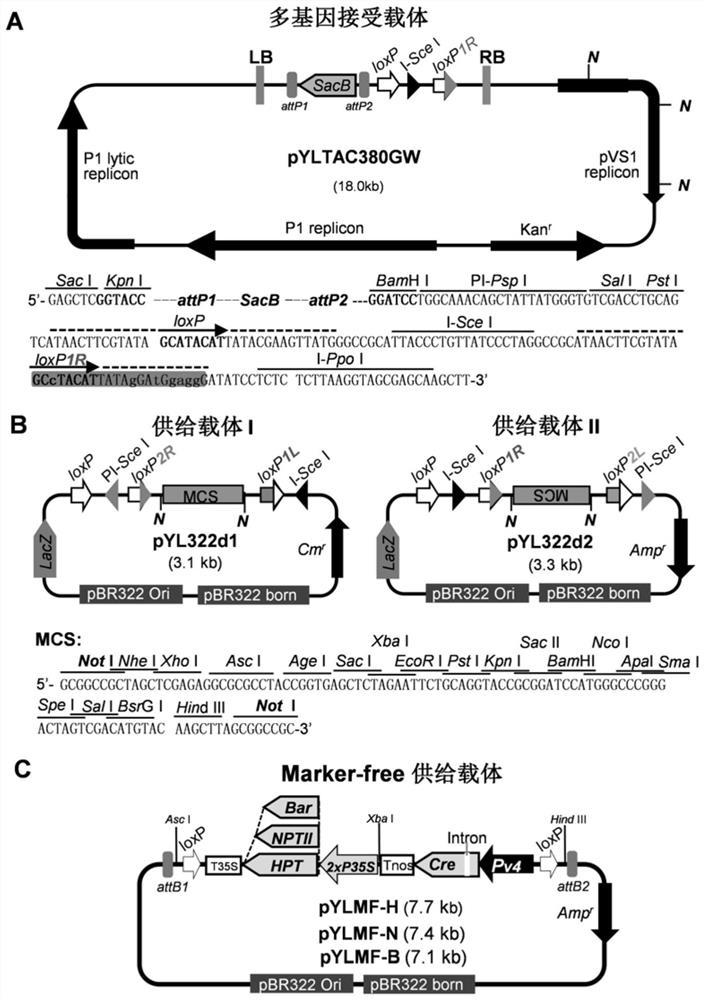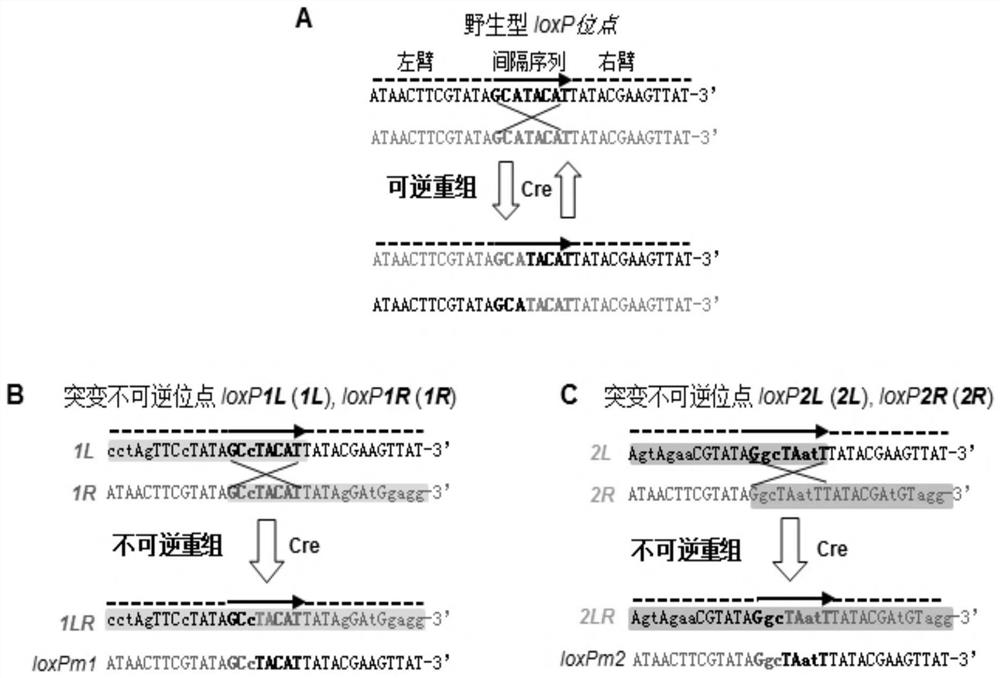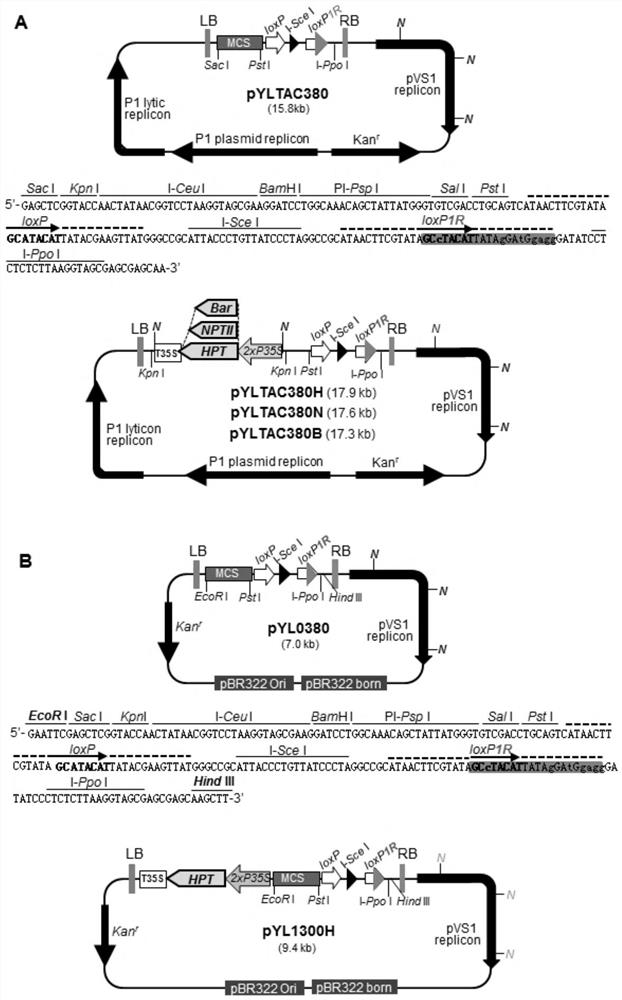A kind of multi-gene assembly vector system and its multi-gene assembly method
A vector system and multi-gene technology, applied in the field of multi-gene assembly vector system and its multi-gene assembly, can solve the problems of difficulty in use, cumbersome complexity, difficulty and the like
- Summary
- Abstract
- Description
- Claims
- Application Information
AI Technical Summary
Problems solved by technology
Method used
Image
Examples
Embodiment 1
[0097] Construction of acceptance vector
[0098] S1. Construction of acceptance vectors pYL0380 and pYL1300H
[0099] Such as Figure 5 As shown in A, the sequence (EcoR I / Sac I / Kpn I / I-Ceu I / I-Ceu I / BamH I / PI-Psp I / Sal I / Pst I / loxP / I-Sce I / loxP1R / I-Ppo I / Hind III, image 3 B, this sequence is as shown in SEQ ID NO.4), after EcoR I and Hind III double enzyme digestion, connect into pCAMBIA0380 and pCAMBIA1300 plasmid (Australian CAMBIA company) through EcoR I and Hind III double enzyme digestion, obtain accepting vector pYL0380 and acceptor vector pYL1300H.
[0100] S2. Construction of acceptance vector pYLTAC380
[0101] Such as Figure 5 As shown in B, the TAC vector pYLTAC747 plasmid (disclosed in the literature "Lin et al., 2003. Efficient linking and transfer of multiple genes by a multigene assembly and transformation vector system. Proc Natl Acad Sci., 100:5962-5967") is Template, carry out PCR amplification with primer P1 / P2 (primer 5' end contains XbaI site), ...
Embodiment 2
[0107] Construction of supply vector I and supply vector II
[0108] S1. Construction of supply vector I plasmid pYL322d1
[0109] Such as Figure 6 As shown in A, use primers P7 / P8 (the 5' ends of the primers contain BssH II / EcoR V sites and Mlu I sites respectively) and P9 / P10 (the 5' ends of the primers contain BssHII and Mlu I sites respectively), and use Figure 5 The pYL1300H and pYLSV plasmids constructed in A (disclosed in the literature "Lin et al., 2003. Efficient linking and transfer of multiple genes by a multigene assembly and transformation vector system. Proc Natl Acad Sci., 100:5962-5967") were used as templates Perform PCR amplification to obtain BssHII / EcoR V / pBR322 replicon / Mlu I fragment and BssHII / Cm r / Mlu I fragment (insert fragment I). The intermediate vector d1-I was obtained by double digestion with BssH II and Mlu I and ligation; the commercially synthesized fragment containing BssH II site BssH II / loxP / PI-Sce I / loxP2R / MCS / loxP1L / I-Sce I / BssH II...
Embodiment 3
[0113] Construction of marker-free supply plasmid
[0114] Such as Figure 7 As shown, use long primers P15 / P16 (the 5' end of the primers contain Xba I / Asc I / attB1 sites and HindIII / Xba I / attB2 sites respectively), and use the supply vector II plasmid pYL322d2 as a template for PCR amplification to obtain Xba I / Asc I / attB1 / pBR322 Replicon / Amp r The backbone fragment of / attB2 / HindIII / Xba I was cut and self-ligated with Xba I to obtain the intermediate vector pYLMF-0.
[0115] Using the DNA of rice variety Zhonghua 11 as a template, use primers P17 / P18 to amplify the promoter PV4 of the anther-specific expression gene Villin 4 (gene number Os04g0604000) as fragment 1, and use primers P19 / P20 to use Escherichia coli NS3529 genomic DNA as a template Amplify the Cre gene coding region (sequence is the same as GenBank No.DQ340306) to obtain fragment 2, use primers P21 / P22 to amplify the Nos terminator Tnos from plasmid pCAMBIA1305 (CAMBIA company) as fragment 3, and use the abov...
PUM
 Login to View More
Login to View More Abstract
Description
Claims
Application Information
 Login to View More
Login to View More - R&D
- Intellectual Property
- Life Sciences
- Materials
- Tech Scout
- Unparalleled Data Quality
- Higher Quality Content
- 60% Fewer Hallucinations
Browse by: Latest US Patents, China's latest patents, Technical Efficacy Thesaurus, Application Domain, Technology Topic, Popular Technical Reports.
© 2025 PatSnap. All rights reserved.Legal|Privacy policy|Modern Slavery Act Transparency Statement|Sitemap|About US| Contact US: help@patsnap.com



